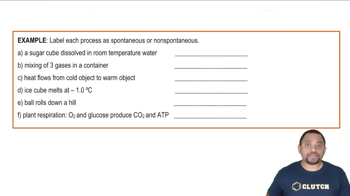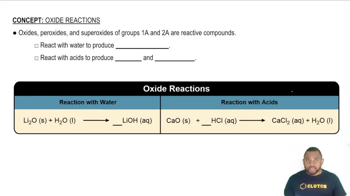Consider this reaction occurring at 298 K: BaCO3(s) ⇌ BaO(s) + CO2( g) b. If BaCO3 is placed in an evacuated flask, what is the partial pressure of CO2 when the reaction reaches equilibrium?
Living organisms use energy from the metabolism of food to create an energy-rich molecule called adenosine triphosphate (ATP). The ATP acts as an energy source for a variety of reactions that the living organism must carry out to survive. ATP provides energy through its hydrolysis, which can be symbolized as follows: ATP(aq) + H2O(l) → ADP(aq) + Pi(aq) ΔG°rxn = -30.5 kJ where ADP represents adenosine diphosphate and Pi represents an inorganic phosphate group (such as HPO42-). b. The free energy obtained from the oxidation (reaction with oxygen) of glucose (C6H12O6) to form carbon dioxide and water can be used to re-form ATP by driving the given reaction in reverse. Calculate the standard free energy change for the oxidation of glucose and estimate the maximum number of moles of ATP that can be formed by the oxidation of one mole of glucose.
 Verified step by step guidance
Verified step by step guidance
Verified video answer for a similar problem:
Key Concepts
Adenosine Triphosphate (ATP)

Free Energy Change (ΔG)

Oxidation of Glucose

Consider this reaction occurring at 298 K: BaCO3(s) ⇌ BaO(s) + CO2(g) c. Can the reaction be made more spontaneous by an increase or decrease in temperature? If so, at what temperature is the partial pressure of carbon dioxide 1.0 atm?
Living organisms use energy from the metabolism of food to create an energy-rich molecule called adenosine triphosphate (ATP). The ATP acts as an energy source for a variety of reactions that the living organism must carry out to survive. ATP provides energy through its hydrolysis, which can be symbolized as follows: ATP(aq) + H2O(l) → ADP(aq) + Pi(aq) ΔGrxn ° = -30.5 kJ where ADP represents adenosine diphosphate and Pi represents an inorganic phosphate group (such as HPO42-). a. Calculate the equilibrium constant, K, for the given reaction at 298 K.
These reactions are important in catalytic converters in automobiles. Calculate ΔG° for each at 298 K. Predict the effect of increasing temperature on the magnitude of ΔG°.
a. 2 CO(g) + 2 NO(g) → N2(g) + 2 CO2(g)
b. 5 H2(g) + 2 NO(g) → 2 NH3(g) + 2 H2O(g)
c. 2 H2(g) + 2 NO(g) → N2(g) + 2 H2O(g)
d. 2 NH3(g) + 2 O2(g) → N2O(g) + 3 H2O(g)
Calculate ΔG° at 298 K for these reactions and predict the effect on ΔG° of lowering the temperature.
a. NH3(g) + HBr(g) → NH4Br(s)
b. CaCO3(s) → CaO(s) + CO2(g)
c. CH4(g) + 3 Cl2(g) → CHCl3(g) + 3 HCl(g) (ΔG°f for CHCl3(g) is -70.4 kJ/mol.)
